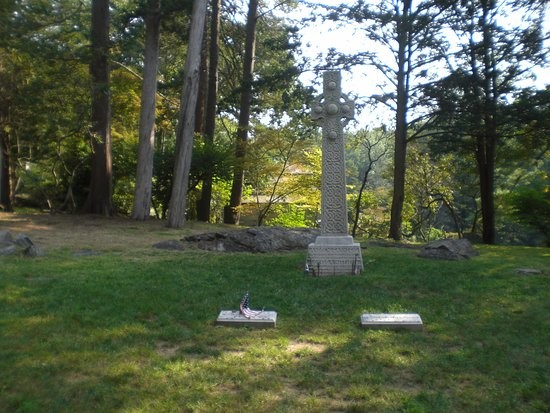Erik Visits an American Grave, Part 19
This is the grave of Andrew Carnegie, self-made man, steel capitalist, and terrible human who tried to buy love for his many, many sins, especially at Homestead, by building libraries around the country.
Born in Scotland in 1835, Carnegie did not grow up wealthy. His father was a handloom weaver who lost work in the late 1840s when the area fell into economic collapse. His mother had to make ends meet selling potted meats. The Carnegies wanted out and borrowed money from Andrew’s uncle to move to the United States in 1848. They ended up in Allegheny, Pennsylvania. Both father and son ended up working in a cotton mill. Andrew was a hard-working boy and caught the attention of his employer almost immediately, leading to a raise, though the work was if anything even harder than working a loom. He then became a telegraph operator and delivery boy, which allowed him to meet the leading businessmen of Pittsburgh. He made an impression, being very good at cultivating the favors of wealthier men. He came under the tutelage of Thomas Alexander Scott, a vile awful man toward workers that someday I will cover in this series. Scott hired Carnegie in 1853 to be a telegraph operator for his railroad. He rose rapidly. In 1859, he was promoted to superintendent of the Western Division of the Pennsylvania Railroad.
Carnegie started to get rich. Like Scott and Pennsylvania Railroad president John Edgar Thomson, the money didn’t come from honest dealing. Please, that was for suckers. It came from corruption, particularly insider trading. Scott allowed Carnegie to buy $500 worth a stock in the Adams Express, which did its business with the Pennsylvania. Of course, a handsome profit soon was realized. That money was then invested in other sure things due to more insider trading and a fortune began to grow.
During the Civil War, Scott was named Assistant Secretary of War and he continued to take care of his protege. Carnegie was given the position of Superintendent of the Military Railways. This put him in charge of a key part of communication and transportation efforts. To be fair, he did a good job here, helping to open the railroads to D.C. when secessionists in Maryland cut the lines at the very beginning of the war, a moment when it was unclear whether the nation’s capitol would fall. He also helped ensure that the Union would have quality telegraph service during the war, which of course was key to victory.
So Carnegie’s Civil War service was positive. But like so many of the people who served the government in the war, such as Jay Cooke, Carnegie was looking after his own financial interests at the same time. He went big into the oil and steel industries during the war, supplying the military with what it needed to win the war, all with a tidy little profit involved. After the war, Carnegie had enough money to leave the railroads behind and start his own steel business.
Soon Carnegie was the leading steel capitalist in the nation. His vertical integration model made him filthy rich. Under his umbrella of Carnegie Steel, he had mills throughout the Pittsburgh region. By the late 1880s, he was the largest producer in the nation not only of steel, but of pig iron, coke, and rails for railroads. He continued his ways of insider trading, buying shares on the bridges his own steel was used to build, for example.
Over half the towns in Pennsylvania rejected his libraries because they knew it was blood money from the dead bodies of his steel workers.
Andrew Carnegie is buried in Sleepy Hollow Cemetery, Sleepy Hollow, New York. Oddly, one can throw a baseball from his grave and hit the grave of Samuel Gompers.




